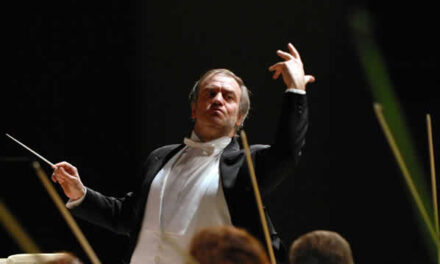North Carolina can be proud of the fine School of Music, Theatre and Dance of its University at Greensboro, as I have remarked in previous comments here at CVNC. The School of Music can boast of having both first-class facilities and a strong faculty. This program featured works by three members of the composition faculty, a professor from the BioMusic program of the Music Research Institute, and visiting composer and performer Eric P. Mandat.
First up was the Cetacean Rhapsody (2011) by Patricia Gray, for alto saxophone and piano, with both pre-recorded whale sounds (slowed to one-quarter speed) and projected whale images. Some of the great works of the modern repertoire have come from the encounter of composers with sounds from the natural realm, particularly bird-song (I think particularly of the works of Olivier Messiaen in this genre), and indeed George Crumb’s work with whale song is well-known (Vox Balaenae for flute, cello and piano). Gray’s Rhapsody, alas, is far over the line into kitsch, with no attempt to incorporate the alien musical language of the whale into the musical language of the human performers (Gray, piano, with saxophonist Mark Engebretsen). Gray’s musical idiom has not advanced beyond about 1880 or so, with a Brahmsian harmonic language which was already backward-looking when he (Brahms) employed it, and the piano part largely made up of meretricious arpeggios up and down the keyboard. For Gray, the entire past century seemingly never took place. Were this a scientific paper, it would never have passed peer review, and indeed for this listener, it casts a problematic light on the seriousness of the other work of the BioMusic program.
“City of Webs,” by Alejandro Rutty, was heard at the New Music Festival at UNCG in 2009 (https://cvnc.org/article.cfm?articleId=1313), and strangely enough, it bears a certain structural resemblance to Gray’s Rhapsody, in that both works are elaborations and comments on pre-existing sound material, in the latter case with live input from piano (Rutty), clarinet (Eric P. Mandat), and saxophone, (Engebretson). Rutty’s source, a spoken interpretation of a poem by Michael Basinsky, is far more nuanced, and the resulting musical responses are more detailed, more modern in style, and far more in-drawing, holding the listener’s interest for a span three times longer than that of the Rhapsody.
After intermission came a set of five Folk Songs (1986) for solo clarinet, composed and performed by Eric P. Mandat (visiting from Southern Illinois University at Carbondale). The first four were accomplished explorations of the many extended technical possibilities of the clarinet, including multiphonics, and even the use of the instrument as a sort of shakuhachi (with the performer removing the mouthpiece and producing sounds by blowing across the edge of the exposed tube). The last movement was more traditional in style, and displayed Mandat’s truly virtuoso skills as a clarinetist.
Gregory Carroll’s Nocturne (2002) for flutes and marimba was essentially a sort of alap (slow, lyrical movement from a north Indian raga), set for alto flute/flute with marimba, in which all the melodic interest is given to the flute, and the marimba serves a simple accompaniment role (a little more ambitious than the usual tambura of Hindustani music, but not much). It was competently but not compelling performed, and to these ears did not add much to the musical discourse.
“Sharpie” (2010) by Mark Engebretson is named for the familiar marker, and was in three connected sections, with two reedists taking the lead (clarinet/bass clarinet, alto/baritone saxophone), with the piano providing energetic support. Engebretson writes in a thoroughly contemporary idiom, and is especially successful in writing for the reeds, with the quick, concluding section offering a virtuoso display of unison passagework; a fine piece that will repay with multiple hearings, and which brought the evening to a rousing conclusion.












